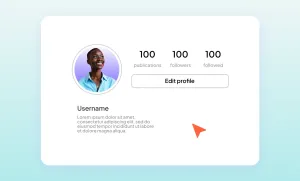If you've got a digital footprint, you technically already have a personal brand, whether you’ve thought about it or not.
Every post, comment, or project you share shapes how people see you. So the real question isn’t if you have one: it’s whether you’re being intentional about it!
A strong personal brand helps people understand what you care about, what you’re good at, and why they might want to work with you, follow you, or trust your voice. So let’s take a closer look at what that actually means, and how to build one that feels like you.
Key Takeaways
- Your digital footprint is your personal brand, the key is to shape it intentionally. Every post, comment, or project sends a message. The goal is to make that message clear and true to who you are.
- Personal brands focus on people, not products. They reflect your values, skills, and personality, and work especially well for freelancers, creators, and founders looking to build trust.
- You can build a personal brand and a business brand at the same time. When done well, they can reinforce each other.
- Strong personal brands are built through clarity, consistency, and storytelling. Choose what you want to be known for, speak in your real voice, and share your journey, even the messy parts.
- Your online presence needs regular check-ins. A strong personal brand evolves, so reviewing your bios, platforms, and content helps make sure they still reflect where you are and what you care about.
What is a Personal Brand?
A personal brand is built around you as an individual. It’s how you present your personality, values, skills, and expertise to the world. It’s not just what you do, it’s how you do it and why you do it. Personal branding is especially powerful for freelancers, consultants, content creators, and founders who want to build trust and connection with their audience.
Take Seth Godin or Marie Forleo, for instance. Their personal brands are recognizable because they consistently present themselves authentically, whether they’re writing a blog post, recording a podcast, or sharing an opinion on social media.
What is a Business Brand?
Meanwhile, a business brand is built around a company, product, or service. It represents the identity of a business as a whole, rather than the people behind it. Business branding includes things like logos, taglines, customer service tone, messaging, and visual style. It’s all about creating consistency and recognition at scale.
Examples include Starbucks, known as a heaven-on-earth for coffee lovers. It’s carefully crafted, designed, and introduced to us, but it isn’t tied to a single person; they’re bigger than any one individual.
Personal Brand vs Business Brand: Can You Have Both?
A personal brand and a business brand can work together. In fact, many successful entrepreneurs use both. For example, Elon Musk has a strong personal brand that complements Tesla and SpaceX. His personal visibility brings attention and personality to his companies, while the business brands stand on their own in terms of innovation and product quality.
A similar example is Selena Gomez and Rare Beauty, the makeup brand that the singer and actress launched. Rarehas its own mission and voice. However, Selena’s personal values clearly shape the brand. Her advocacy for self-acceptance and emotional well-being drives the brand, and in turn, Rare Beauty reinforces her personal brand, positioning her not just as a celebrity but as a changemaker in the beauty industry.
Personal Brand Examples
One of the easiest ways to understand personal branding is to see it in action. Real people, doing real things, in their unique voice. Here are some personal brand examples that can help you dive deeper into what personal branding is and get inspired just as fast.
1. Emma Chamberlain
Emma Chamberlain’s personal brand is all about being real, relatable, and refreshingly unfiltered, and that’s exactly what’s made her so magnetic. From her early YouTube days to becoming a fashion world favorite, Emma Chamberlain stayed true to her voice: a mix of dry humor, introspection, and “this is who I am” honesty. That same energy runs through everything she does.
Her podcast Anything Goes feels like a 3 AM conversation with her: raw, rambling, and thoughtful. It gives her audience a deeper look into the person behind the camera, and the audience can feel it.
Her coffee brand, Chamberlain Coffee, grew into a natural extension of her personality over time, born from her well-known love of coffee and wrapped in fun, down-to-earth branding that feels very Emma. It all fits because it all comes from the same place: a personal brand that doesn’t try to be perfect, just real.
2. Neil Patel
Neil Patel has built a personal brand that’s practically synonymous with digital marketing. He’s known for breaking down complex SEO and marketing strategies into simple, actionable advice without the fluff. You’ve likely experienced the clarity and consistency of his brand by landing on his blog, watching one of his YouTube tutorials, or using tools like Ubersuggest.
Neil shows up as both an expert and a teacher: approachable, data-driven, and incredibly consistent across platforms. His content always aims to deliver value first, which is exactly why people trust him. From consulting major companies to helping small businesses grow their traffic, his personal brand has made him a go-to authority in the digital space, built not on hype but on helpfulness.
3. Cleo Abram
Cleo Abram has carved out a personal brand that’s all about curiosity, clarity, and optimism about the future. As a video journalist and creator, she’s known for breaking down complex topics, especially in science, tech, and innovation, into visually striking, easy-to-understand stories. Her signature style blends sharp visuals with thoughtful, enthusiastic explanations, making topics like quantum computing or AI feel accessible, not intimidating.
From her days at Vox to launching her show, Huge If True, Cleo’s brand has stayed consistent: smart, future-focused, and deeply human. She doesn’t just report on big ideas, she invites you into them, making her one of the most trusted and distinctive voices in educational content today.
How to Build a Personal Brand: 5 Core Steps
A strong personal brand doesn’t start with visuals or buzzwords. It starts with knowing what you’re doing this for, and how you want to show up. These steps are here to help you build something honest and useful. Something that actually fits you, instead of some ideal version of what a personal brand is supposed to look like.
- Figure out what you want this to lead to. Take a moment to think about what you want from this. Do you want more work opportunities? More freedom? More clarity around your ideas?
- Choose what you want to be known for. People remember clear things. So pick a few ideas or skills you want to be associated with, and let those guide how you show up.
- Tell a version of your story that feels true now. Your story can evolve. The version you share today doesn’t need to cover everything or stay the same forever. Just pick a version that reflects where you’re at and what you care about right now.
- Make a plan that fits your actual life. Posting every day or being on every platform might work for someone else, but that doesn’t mean it’s right for you. The goal is to be consistent in a way that feels doable.
- Check in with how you’re showing up online. Every once in a while, take a step back and look at how you appear across platforms. Ask yourself if your bios and feeds still feel aligned with who you are and what you’re working on.
Personal Branding Tips
At the heart of every great personal brand is one simple truth: it feels like you. Not a version of you that’s overly polished or trying to fit into a mold, but the real you, with your voice, values, quirks, and point of view. If you’re not sure where to start, these personal branding tips will help you build something authentic, sustainable, and unmistakably yours:
1. Define Your “Why” and “Who” Before Your Aesthetic
Before picking colors, fonts, or a catchy tagline, get clear on who you are and why you want to build a personal brand. Is it to attract clients? Land speaking gigs? Share what you know? Just be famous? Help a cause? Your “who” and "why" will help you choose the right niche and audience and guide everything else, keeping you grounded in purpose, not just style.
2. Pick 2-3 Content Pillars and Stick to Them
Consistency builds recognition. Choose a few themes (like design, mental health, or storytelling) and show up regularly with insights or experiences related to those. This makes your personal brand impressive and memorable without feeling all over the place.
3. Use Your Voice, Not Just Your Face
Personal branding is about showing how you think. Write how you speak. Share opinions. Tell short stories. Let your tone come through in your captions, emails, bios, and posts. That’s what helps people feel like they know you.
4. Build in Public (Even the Messy Parts)
Don’t wait until everything is perfect. Share what you’re learning, what you’re building, or what you're figuring out. Documenting your journey, successes, and missteps makes you more human and relatable, also building trust faster than polished results alone.
5. Audit Your Digital Footprint Regularly
Google yourself. Check your LinkedIn, Instagram, personal website, and anywhere else you show up online. Ask: Does this reflect who I am and what I care about today? Your brand isn’t static, so revisit and refresh as you grow.
Create your Personal Brand with Podcastle
Creating a personal brand takes time. What helps is having tools that make it easier to show up and share what you know.
With Podcastle, you can record clean audio, create polished video, and repurpose everything into formats that fit your workflow. Whether you’re building a podcast, filming short clips, or recording professional voiceovers, Podcastle helps you stay consistent.
- Improve your audio and video quality automatically: Spend less time editing. Let AI help you sound clear and look sharp with one click.
- Resize your videos for every social platform. Post the same message in the right format, from Reels to YouTube Shorts, without redoing everything.
- Use AI voiceovers when you don’t feel like recording: Choose from over 1,000 natural-sounding voices to bring your scripts to life when you’re short on time or energy.
Building a personal brand doesn’t need to feel overwhelming. You already have the ideas. Podcastle helps you share them in a way that feels real, sounds professional, and actually fits into your workflow.








